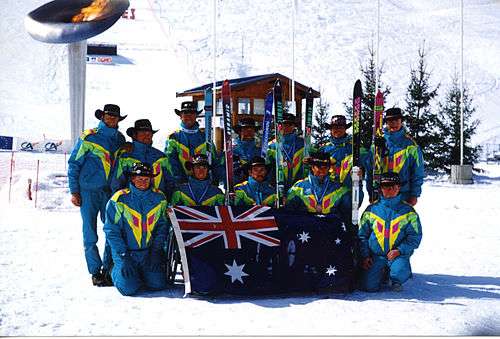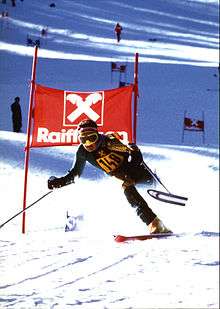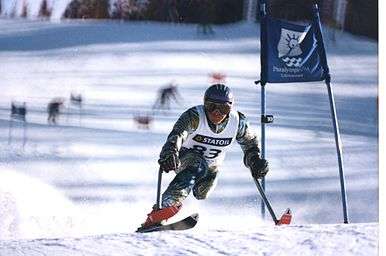Australia at the 1992 Winter Paralympics
| Australia at the 1992 Winter Paralympics | |||||||||
|---|---|---|---|---|---|---|---|---|---|
 | |||||||||
| IPC code | AUS | ||||||||
| NPC | Australian Paralympic Committee | ||||||||
| Website |
www | ||||||||
| in Tignes-Albertville | |||||||||
| Competitors | 5 in 1 sport | ||||||||
| Medals Ranked 12th |
| ||||||||
| Winter Paralympics appearances (overview) | |||||||||
Australia competed at the 1992 Winter Paralympics in Tignes and Albertville in France. They were the first winter Paralympics to be celebrated concurrently with the Olympic Games. The official logo of the Games was designed by Jean-Michel Folon.It depicts a bird with broken wings, soaring high across the peak of a mountain. This was used to reflect the sporting abilities of the athletes at the Games.[1] The official mascot, Alpy, designed by Vincent Thiebaut, represented the summit of the Grande Motte mountain in Tignes. Alpy was shown on a mono-ski to demonstrate its athleticism and the colours of white, green and blue were used to represent purity/snow, hope/nature and discipline/the lake.[2] The 1992 Games were where Australia won their first winter medals at the Paralympics. Michael Milton won Australia's first gold with a win in the Men's Slalom LW2. Milton also won a silver medal in the Men's Super G LW2.[3] At these Games, Australia was represented by 5 male athletes. Australia was placed 12th in the overall medal tally for the Winter Games winning a total of 4 medals: 1 gold, 1 silver and 2 bronze.[4][5]
Background
Selection of the host city
On 16 October 1986 at the IOC session in Lausanne, Switzerland Albertville in France was awarded the right to host the 1992 winter Olympic Games. Almost a year earlier in November 1985 André Auberger, President of the French Sport Federation for the Disabled, had written to Michel Barnier, President of the French Olympic bid committee, to request that they also consider hosting the Paralympic Games should their Olympic bid be successful. On November 3rd1986 Barnier confirmed his support to the request and on 31 January 1987 at the meeting of the International Co-ordinating Committee in Copenhagen, Denmark the right to host the 1992 winter Paralympic Games was awarded to France. The contract was finally signed on 22 April 1989.[6]
Opening ceremony
The opening ceremony for the Tignes winter Paralympic Games commenced at 4.00pm on Wednesday 25 March at the foot of the main competition pistes for the Games. Guest of Honour for the ceremony was President of the French Republic Francois Mitterrand who arrived at 5.00pm. The delegations entered the arena in French alphabetical order and every 45 seconds a para-glider in the colours of each country descended into the arena and spread out in front of the delegations. Short speeches by the President of the ICC Jens Broman and the French President were followed by the official opening of the Games by President Mitterrand. This was followed by the entrance of the Paralympic flame and the lighting of the Olympic cauldron by French Nordic skier Luc Sabatier assisted by Fabrice Guy. The athletes and officials oaths were then taken by Ludovic Rey-Robert on behalf of the athletes and a currently unknown female official. This was followed by an aerobatic display by six hang-gliders over the stadium to music by French composer Michel Colombier, choreographed by American dancer Dany Ezralow with the harmonica solo being performed by Belgian musician Toots Thielemans. The ceremony ended with the release of balloons to the strains of ‘The Ode to Joy’ followed by the exit of the team delegations.[7]
The Games themselves
Despite being badged as Tignes-Albertville in all publicity material the fifth winter Paralympic Games actually only took place in Tignes. The fact that the Games only took place in Tignes where there were no ice sport venues, combined with an apparent lack of entries from the nations in ice sport events, meant that only Alpine and Nordic events were held. A total of 365 athletes from 24 nations competed in 79 medal events. For the first time, demonstration events in Alpine and Nordic Skiing for athletes with an intellectual disability and Biathlon for the visually impaired were added to the programme. In addition, this was the first time at a Winter Paralympics that the athletes were all accommodated in an Athlete's Village as opposed to hotels, which had been the case at previous winter Games. The Games were officially opened by French President Francois Mitterrand with the Opening Ceremony and all other ceremonial events being held in front of the finish area for the Alpine Skiing events. This area was named the Lognan Stadium. The Games were covered by 300 journalists and 15 reporters from various television channels. According to the Official Report the Games cost 41,638,810.98 French Francs and actually made a small profit of 392,471.73 French Francs.[8]
Closing ceremony
The closing ceremony for the Tignes winter Paralympic Games commenced at 5.00pm on Wednesday 1 April at the foot of the main competition pistes for the Games. The ceremony was attended by Michel Gillibert, State Secretary to the Handicapped and Life Injured, paralysed French sailor Florence Arthaud, who acted as Godmother to the French Paralympic team in Tignes, the Mayor of Lillehammer, hosts to the next winter Paralympic Games in 1994 and representatives from COPTA, ICC and Tignes. The closing ceremony was a simple affair. There was a parade of nations and a descent of all the medal winners together. The ceremony concluded with the extinguishing of the flame and the take-off of a deltaplane bearing the broken-winged bird ‘Folon’ symbol, which flew away into the distance.[9]
Athletes

Michael Milton - Alpine Skiing
Michael Norton - Alpine Skiing
David Munk - Alpine Skiing
Rod Hacon - Alpine Skiing
Kyrra Grunnsund - Alpine Skiing
David McPherson - Alpine Skiing[10]
Notable performances

Michael Milton won a gold medal in the Men's Slalom LW2 event, for which he received a Medal of the Order of Australia,[11] and a silver medal in the Men's Super-G LW2 event.[4] He became the first Australian to win a gold medal at a winter Olympics or Paralympics.[12] That year he also won the slalom in the Austrian championships, and in 1993 he won both the slalom and super giant slalom at the Columbia Crest Cup.[12]
Michael Norton won a bronze medal for his efforts in the Men's Slalom LW11[13]
David Munk also won a bronze medal for his Men's Super-G LW11 run[13]
Medal winners
| Medal | Name | Sport | Event | |
|---|---|---|---|---|
| | Milton, MichaelMichael Milton | Alpine Skiing | Men's Slalom LW2 | |
| | Milton, MichaelMichael Milton | Alpine Skiing | Men's Super-G LW2 | |
| | Norton, MichaelMichael Norton | Alpine Skiing | Men's Slalom LW11 | |
| | Munk, DavidDavid Munk | Alpine Skiing | Men's Super-G LW11 | |
Administration
Team officials were:
Graeme Morris (Manager/Head Coach);
Dean Sheppard (Assistant Coach);
Eddie Jesiolowski, David Howells and Alan Dean (Team Assistants) [15]
Events
The 5 athletes who competed at these Games were involved in 4 of the 5 available alpine skiing events. These events were: Downhill, Slalom, Giant Slalom and Super-G. The only alpine skiing event that no Australian participated in was Super Combined. A short description of these events are as follows:
Downhill
- Each athlete competes one run down the course with their finish time determining the final order based on ascending time. Athletes ski down a long, steep course and must pass through a relatively few number of gates. If an athlete misses a gate they are disqualified. For weather, safety and other reasons, the jury can decide to have two-run downhill if the vertical drop does not comply.
Slalom
- Each athlete competes two runs on the same day on different courses. Times from the two runs are added together to determine the final order based on ascending total time. It is a technical event over a shorter course than other events but with a high number of gates that the athlete must negotiate. If an athlete misses a gate they are disqualified.
Giant slalom
- Each athlete completes two runs on the same day on different courses. Times from the two runs are added together to determine the final order based on ascending total time. It is a technical event with a longer course and fewer gates than the slalom. The number of gates is determined by the vertical drop of the course. If an athlete misses a gate they are disqualified.
Super-G
- A speed event where each athlete completes one run down the course with their finish time determining the final order based on ascending time. The course is generally shorter than downhill but longer than slalom and giant slalom.
Super combined
- A combined competition which represents the final result of two disciplines - usually one of either a downhill or super-G and a single run of slalom. Each athlete competes two runs on the same day on different courses. Times from the two runs are added together to determine the final order based on ascending total time.[16]
Classifications
Standing skiiers

- LW1 - standing: double leg amputation above the knee
- LW2 - standing: single leg amputation above the knee
- LW3 - standing: double leg amputation below the knee, mild cerebral palsy, or equivalent impairment
- LW4 - standing: single leg amputation below the knee
- LW5/7 - standing: double arm amputation
- LW6/8 - standing: single arm amputation
- LW9 - standing: amputation or equivalent impairment of one arm and one leg
Sitting skiiers
.jpg)
- LW10 - sitting: paraplegia with no or some upper abdominal function and no functional sitting balance
- LW11 - sitting: paraplegia with fair functional sitting balance
- LW12 - sitting: double leg amputation above the knees, or paraplegia with some leg function and good sitting balance
Visual impairments
- B1 - visually impaired: no functional vision
- B2 - visually impaired: up to ca 3-5% functional vision
- B3 - visually impaired: under 10% functional vision
In IPC Alpine Skiing, you will see athletes with visual impairment skiing with a guide. The guide skis in front of the athlete and verbally gives directions to the athlete. [17]
 Results
Results
| Athlete | Event | Time | Rank |
|---|---|---|---|
| Kyrra Grunnsund | Men's Giant Slalom LW4 | 2:28.29 | 7 |
| Men's Slalom LW4 | 1:25.50 | 8 | |
| Rod Hacon | Men's Giant Slalom LW11 | DNF | |
| Men's Slalom LW11 | DNF | ||
| Michael Milton | Men's Downhill LW2 | 1:17.39 | 7 |
| Men's Giant Slalom LW2 | 2:28.15 | 4 | |
| Men's Slalom LW2 | 1:14.11 | ||
| Men's Super-G LW2 | 1:26.62 | ||
| David Munk | Men's Downhill LW11 | DNF | |
| Men's Giant Slalom LW11 | DNF | ||
| Men's Super-G LW11 | 1:39.67 | ||
| Michael Norton | Men's Downhill LW11 | DNF | |
| Men's Slalom LW11 | 1:55.68 |
David McPherson a sit skier was forced top withdraw from the team prior to Games due to a fall in Thredbo, New South Wales in September 1991.[15]
Participating nations

Below is a list of all 24 Nations that participated in the Games:
- Australia
- Austria
- Belgium
- Canada
- Czechoslovakia
- Denmark
- Estonia
- Finland
- France
- Germany
- Great Britain
- Italy
- Japan
- Liechtenstein
- Netherlands
- New Zealand
- Norway
- Poland
- South Korea
- Spain
- Sweden
- Switzerland
- United States
- Unified Team
Countries appearing in bold are those appearing at a Winter Paralympic Games for the first time[19]
See also
- Australia at the Winter Paralympics
- 1992 Winter Paralympics
- Australia at the 1992 Summer Paralympics
References
- ↑ Official Logo, From Stoke Mandeville to Sochi
- ↑ Official Mascot, From Stoke Mandeville to Sochi
- ↑ "Paralympic Games History - Winter". Australian Paralympic Committee. 2011. Retrieved 26 September 2011.
- 1 2 "Historical Results Archive". IPC. Retrieved 24 October 2016.
- ↑ McDonald, Margie (15 March 2010). "Jessica Gallagher rejoices in Paralympic history". The Australian. Sydney, Australia. Retrieved 8 November 2011.
- ↑ Selection of the Host City, From Stoke Mandeville to Sochi
- ↑ Opening Ceremony, From Stoke Mandeville to Sochi
- ↑ Overview of the Games, From Stoke Mandeville to Sochi
- ↑ Closing Ceremony, From Stoke Mandeville to Sochi
- ↑ "Australia at 1992 Paralympics". International Paralympic Committee Historical Results Database. Retrieved 17 August 2016.
- ↑ "It's an Honour". OAM. Retrieved 25 October 2016.
- 1 2 "The history of people with disabilities in Australia – 100 years: Sport". Disability Services Australia. Retrieved 25 October 2016.
- 1 2 "Australia at 1992 Paralympics". International Paralympic Committee Historical Results Database. Retrieved 25 October 2016.
- ↑ "Australia at 1992 Paralympics". International Paralympic Committee Historical Results Database. Retrieved 14 January 2013.
- 1 2 "Special Paralympic edition". To t' bottom. 1 (1): 2. 1992.
- ↑ "About the Sport". IPC. Retrieved 24 October 2016.
- ↑ "Classifications". IPC. Retrieved 24 October 2016.
- ↑ "Australia - 1992 Winter Paralympics". International Paralympic Committee Historical Results Database. Retrieved 19 January 2013.
- ↑ Participating Nations, From Stoke Mandeville to Sochi